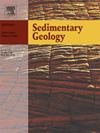Sedimentological and ichnological characterization of tide-dominated succession during transgression in the Lower Cretaceous Zubair Formation, central Mesopotamian Basin
IF 2.9
2区 地球科学
Q1 GEOLOGY
引用次数: 0
Abstract
Depositional processes recorded by coastal deposits may vary rapidly during transgression due to the interactions of wave, river, and tidal processes, leading to the diversity of facies models. Reconstructing a reliable, detailed facies model associated with depositional processes remains challenging unless ichnological features are considered. Integrated sedimentological and ichnological analyses of high-resolution core samples, wireline log, and seismic data from the Lower Cretaceous Zubair Formation, central Mesopotamian Basin, are undertaken to propose a tide-dominated model within transgressive succession. The presence of sporadic river-influenced sedimentary structures, variability in ichnodiversity and bioturbation intensity, and abundant tidal physical indicators attest to the strong influence of tide-generated currents during deposition. In a transgressive upward-fining succession, seven facies associations are identified based on differences in sedimentological and ichnological indicators, and further grouped into two environments (tide-dominated estuary and open coast tidal flat), which are both considered as first-order tidal coastal environments. Deposits of estuaries are occupied by mixed Cruziana-Skolithos ichnofacies and dominance of channel-bar complexes, while local storm-influenced structures, higher ichnodiversity and bioturbation intensity, and well-expressed Cruziana and Skolithos ichnofacies clearly characterize the open coast. River-dominated paleovalley evolved into the tide-dominated estuary and then transformed into the open coast tidal flat as global sea-level rose, with increasing ichnodiversity, bioturbation intensity, and weakening fluvial influence. For the first time in the region, distinct deposits of estuary and open coast are recognized, indicating the development of facies diversity during long-term transgression. High accommodation, topographic features, limited sediment supply, and sea level rise are responsible for the spatiotemporal differential distribution of these two depositional systems. At the regional scale, tidal environments, river-influenced, and river-dominated deltas were distributed along the coastline from northwest to southeast due to the relatively increasing sediment supply from the Arabian Shield towards the southeast. The results of this study improve our understanding of regional paleogeography in the central Mesopotamian Basin, NE Arabian Plate, during the Barremian, and provide a case for understanding the diversity and sedimentary evolution of tidal facies models, which can be applied to other transgressive sequences in deep-time basins worldwide.

美索不达米亚盆地中部下白垩统Zubair组海侵潮控演替的沉积学与技术特征
在海侵过程中,由于波浪、河流和潮汐作用的相互作用,海岸沉积记录的沉积过程可能发生快速变化,导致相模式的多样性。除非考虑到技术特征,否则重建与沉积过程相关的可靠、详细的相模型仍然具有挑战性。对美索不达米亚盆地中部下白垩统Zubair组的高分辨率岩心样品、电缆测井和地震数据进行了综合沉积学和技术分析,提出了海侵演替中潮汐主导的模型。零星河流影响的沉积构造的存在、生物多样性和生物扰动强度的变化以及丰富的潮汐物理指标证明了潮汐流在沉积过程中的强烈影响。根据沉积学和技术指标的差异,在海侵向上细化的演替过程中,划分出7种相组合,并将其划分为2种环境(潮汐主导的河口环境和开阔海岸潮滩环境),均为一级潮汐海岸环境。河口沉积以克鲁济亚纳-斯科利礁混合相为主,以水道-沙洲复合体为主,而局部受风暴影响的构造、较高的生物多样性和生物扰动强度,以及表现良好的克鲁济亚纳和斯科利礁相,则明显具有开阔海岸的特征。随着全球海平面的上升,以河流为主导的古河谷演变为以潮汐为主导的河口,再转变为开阔的海岸潮滩,生物多样性增加,生物扰动强度增强,河流影响减弱。区内首次发现了明显的河口和开阔海岸沉积,表明该区在长期海侵过程中发育了相多样性。可容性高、地形特征、沉积物供给有限和海平面上升是造成两种沉积体系时空分布差异的主要原因。在区域尺度上,由于阿拉伯盾向东南方向的输沙量相对增加,潮汐环境、河流影响三角洲和河流主导三角洲沿海岸线由西北向东南分布。研究结果提高了我们对巴雷米亚盆地中部、东北阿拉伯板块区域古地理的认识,并为了解潮相模式的多样性和沉积演化提供了一个案例,可应用于全球其他深时盆地海侵层序。
本文章由计算机程序翻译,如有差异,请以英文原文为准。
求助全文
约1分钟内获得全文
求助全文
来源期刊

Sedimentary Geology
地学-地质学
CiteScore
5.10
自引率
7.10%
发文量
133
审稿时长
32 days
期刊介绍:
Sedimentary Geology is a journal that rapidly publishes high quality, original research and review papers that cover all aspects of sediments and sedimentary rocks at all spatial and temporal scales. Submitted papers must make a significant contribution to the field of study and must place the research in a broad context, so that it is of interest to the diverse, international readership of the journal. Papers that are largely descriptive in nature, of limited scope or local geographical significance, or based on limited data will not be considered for publication.
 求助内容:
求助内容: 应助结果提醒方式:
应助结果提醒方式:


